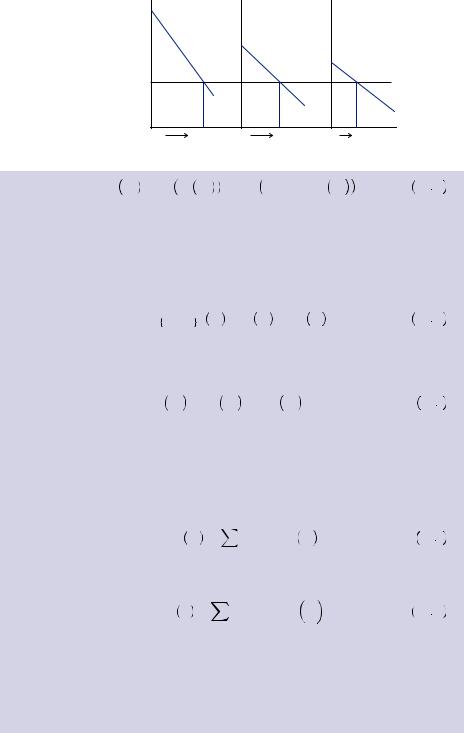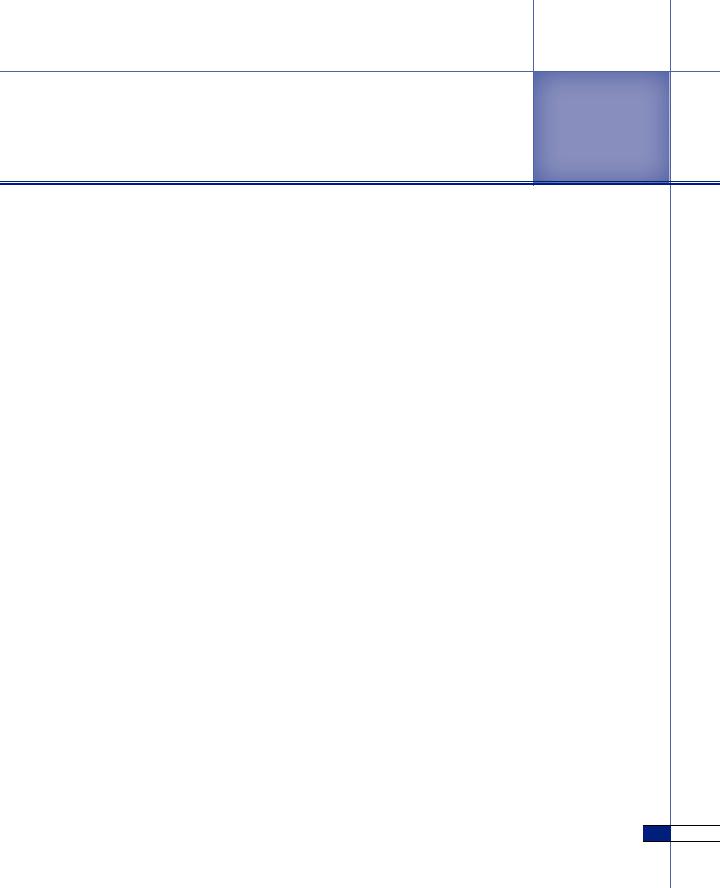
- •Brief Contents
- •Contents
- •Preface
- •Who Should Use this Book
- •Philosophy
- •A Short Word on Experiments
- •Acknowledgments
- •Rational Choice Theory and Rational Modeling
- •Rationality and Demand Curves
- •Bounded Rationality and Model Types
- •References
- •Rational Choice with Fixed and Marginal Costs
- •Fixed versus Sunk Costs
- •The Sunk Cost Fallacy
- •Theory and Reactions to Sunk Cost
- •History and Notes
- •Rational Explanations for the Sunk Cost Fallacy
- •Transaction Utility and Flat-Rate Bias
- •Procedural Explanations for Flat-Rate Bias
- •Rational Explanations for Flat-Rate Bias
- •History and Notes
- •Theory and Reference-Dependent Preferences
- •Rational Choice with Income from Varying Sources
- •The Theory of Mental Accounting
- •Budgeting and Consumption Bundles
- •Accounts, Integrating, or Segregating
- •Payment Decoupling, Prepurchase, and Credit Card Purchases
- •Investments and Opening and Closing Accounts
- •Reference Points and Indifference Curves
- •Rational Choice, Temptation and Gifts versus Cash
- •Budgets, Accounts, Temptation, and Gifts
- •Rational Choice over Time
- •References
- •Rational Choice and Default Options
- •Rational Explanations of the Status Quo Bias
- •History and Notes
- •Reference Points, Indifference Curves, and the Consumer Problem
- •An Evolutionary Explanation for Loss Aversion
- •Rational Choice and Getting and Giving Up Goods
- •Loss Aversion and the Endowment Effect
- •Rational Explanations for the Endowment Effect
- •History and Notes
- •Thought Questions
- •Rational Bidding in Auctions
- •Procedural Explanations for Overbidding
- •Levels of Rationality
- •Bidding Heuristics and Transparency
- •Rational Bidding under Dutch and First-Price Auctions
- •History and Notes
- •Rational Prices in English, Dutch, and First-Price Auctions
- •Auction with Uncertainty
- •Rational Bidding under Uncertainty
- •History and Notes
- •References
- •Multiple Rational Choice with Certainty and Uncertainty
- •The Portfolio Problem
- •Narrow versus Broad Bracketing
- •Bracketing the Portfolio Problem
- •More than the Sum of Its Parts
- •The Utility Function and Risk Aversion
- •Bracketing and Variety
- •Rational Bracketing for Variety
- •Changing Preferences, Adding Up, and Choice Bracketing
- •Addiction and Melioration
- •Narrow Bracketing and Motivation
- •Behavioral Bracketing
- •History and Notes
- •Rational Explanations for Bracketing Behavior
- •Statistical Inference and Information
- •Calibration Exercises
- •Representativeness
- •Conjunction Bias
- •The Law of Small Numbers
- •Conservatism versus Representativeness
- •Availability Heuristic
- •Bias, Bigotry, and Availability
- •History and Notes
- •References
- •Rational Information Search
- •Risk Aversion and Production
- •Self-Serving Bias
- •Is Bad Information Bad?
- •History and Notes
- •Thought Questions
- •Rational Decision under Risk
- •Independence and Rational Decision under Risk
- •Allowing Violations of Independence
- •The Shape of Indifference Curves
- •Evidence on the Shape of Probability Weights
- •Probability Weights without Preferences for the Inferior
- •History and Notes
- •Thought Questions
- •Risk Aversion, Risk Loving, and Loss Aversion
- •Prospect Theory
- •Prospect Theory and Indifference Curves
- •Does Prospect Theory Solve the Whole Problem?
- •Prospect Theory and Risk Aversion in Small Gambles
- •History and Notes
- •References
- •The Standard Models of Intertemporal Choice
- •Making Decisions for Our Future Self
- •Projection Bias and Addiction
- •The Role of Emotions and Visceral Factors in Choice
- •Modeling the Hot–Cold Empathy Gap
- •Hindsight Bias and the Curse of Knowledge
- •History and Notes
- •Thought Questions
- •The Fully Additive Model
- •Discounting in Continuous Time
- •Why Would Discounting Be Stable?
- •Naïve Hyperbolic Discounting
- •Naïve Quasi-Hyperbolic Discounting
- •The Common Difference Effect
- •The Absolute Magnitude Effect
- •History and Notes
- •References
- •Rationality and the Possibility of Committing
- •Commitment under Time Inconsistency
- •Choosing When to Do It
- •Of Sophisticates and Naïfs
- •Uncommitting
- •History and Notes
- •Thought Questions
- •Rationality and Altruism
- •Public Goods Provision and Altruistic Behavior
- •History and Notes
- •Thought Questions
- •Inequity Aversion
- •Holding Firms Accountable in a Competitive Marketplace
- •Fairness
- •Kindness Functions
- •Psychological Games
- •History and Notes
- •References
- •Of Trust and Trustworthiness
- •Trust in the Marketplace
- •Trust and Distrust
- •Reciprocity
- •History and Notes
- •References
- •Glossary
- •Index

|
|
|
|
|
378 |
|
COMMITTING AND UNCOMMITTING |
History and Notes
When Robert Strotz introduced time-inconsistent discounting, he proposed a model that assumed sophistication. The model was originally introduced as a way to explain the wide use of commitment mechanisms. David Laibson, George Akerlof, and others then used extensions of this model in highly influential applications. As complicated as the sophisticated model might seem, it was the model that was originally proposed. The naïve model was proposed as an alternative when it was noted that people often forgo commitment when it could help them. This pair of models explaining time inconsistency has been widely used to explain investment and savings behavior, macroeconomic activity, and procrastination by workers. The implications for marketers are important. Often, less is more. Food distributers could charge more to dieters for smaller portions if purchased in advance (like a frozen meal). Selling commitment mechanisms can be big business. Often the commitment mechanism costs little for the seller to implement, but it can be sold for a substantial price. Credit cards themselves are an interesting example of a commitment mechanism. Someone who has not been able to save for a high-priced consumer item can commit to save for the item ex post. Similar payday loan systems exist for the intertemporally challenged among us. These firms charge ultrahigh interest rates (annualized rates are often in excess of 400 percent) for very small and short-term loans. The ubiquity of such evidence of time inconsistency has helped quasi-hyperbolic discounting models make their way into the mainstream of economic modeling and thought.
Biographical Note
Photo Courtesy of David Laibson
David Laibson (1966–)
A.B., Harvard University, 1988; M.S., London School of Economics, 1990; Ph.D., Massachusetts Institute of Technology, 1994
Held faculty positions at Harvard University
David Laibson’s work on savings rates, retirement portfolios, and other macroeconomic issues has become some of the most widely read and cited work in recent economics history. The application of the quasi-hyperbolic model to savings revitalized the original work of Robert Strotz, bringing it into the

|
|
|
|
Thought Questions |
|
379 |
|
mainstream of economics research. Particularly intriguing is the ability of such timeinconsistent preferences to explain how savers could at once hold long-term illiquid savings devices, yet demonstrate incredible impatience in their savings and consumption patterns. Without behavioral models, these behaviors would appear to be irreconcilable. Some of his other work has highlighted the impact of limits on rational decision making in other macroeconomics contexts, as well as the impact of default mechanisms on savings. In contrast to the theoretical work described in this chapter, much of his work relies heavily on sophisticated econometric analysis of investment data. By using field data generated by natural decisions, Laibson is able to provide clear examples of how behavioral effects are important in a general economics setting. Laibson has won high praise for his work, including election to the National Academy of Sciences.
T H O U G H T Q U E S T I O N S
1.In this chapter and the last, we have presented three models of intertemporal decision making: naïve, sophisticated, and partially naïve. As presented here and in the literature, naïve decision makers seem doomed to repeat their mistakes over and over. This seems unrealistic. Alternatively, sophisticates anticipate their procrastination problem perfectly and avoid procrastinating wherever possible. Thus, sophisticates would never procrastinate unless they anticipated that they would. This, too, seems unrealistic. Finally, the third model allows misperception of how one might act in the future, allowing unexpected procrastination. But this model also allows people to procrastinate forever, never learning from their mistakes.
(a)Write about an experience you have had with procrastination and how the behavior may be explained by one of these models. (Write a mathematical model if you can.)
(b)Write also about what parts of your behavior could not be explained by any of these three models. Is there a way to modify one of these models to include a description of this behavior?
2.Consider the savings club problem from Example 13.1. Suppose again that Guadalupe earns $30 each week but that the time period is only three weeks. In weeks 1 and 2,
instantaneous utility of consumption (for a week of consumption) is given by u c
c =
= c, so that marginal
c, so that marginal
utility of instantaneous consumption is given by 0.5c − 05. In week 3, Guadalupe has utility given by u3 χ
χ = 0.371χ, where χ is the amount spent on
= 0.371χ, where χ is the amount spent on
Christmas gifts (there is no other consumption in week 3). The instantaneous marginal utility of Christmas is given by 0.371. Savings beyond the third period leads to no additional utility. The regular savings account offers an annual interest rate of 5 percent, compounded weekly, whereas placing money in a savings club offers an annual interest rate of r. For the following, it may be useful to use the formulas derived in Example 13.1.
(a)Suppose that δ = 0.97. Solve for the optimal consumption and savings decision in each period, supposing that the decision maker has time-con- sistent preferences. To do this, solve for the amount of consumption in weeks 1 and 2 and the amount of gifts in week 3 that yield equal discounted marginal utilities.
(b)Suppose that β = 0.5. Solve for the optimal savings and consumption decision supposing the decision maker is a naïf.
(c)Now suppose that the decision maker is a sophisticate. Solve for the optimal savings and consumption decisions.
(d)Finally, suppose that the decision maker is a partial naïf, with β = 0.8. Now solve for the optimal
savings and consumption decisions.
(e)Solve for the r that would be necessary to induce
the time-consistent decision maker, the naïf, the sophisticate, and the partial naïf to commit to the Christmas club. What is the optimal savings and consumption profile in this case?

|
|
|
|
|
380 |
|
COMMITTING AND UNCOMMITTING |
3.Consider O’Donoghue and Rabin’s model of choosing when to complete a one-time task. Let δ = 1, β = 0.5 and β = 1. For each of the following profiles, solve for
the time-consistent, naïve, sophisticated, and partially naïve optimal strategy. In each case, suppose that the task must be completed by the end of the fourth period.
(a)v =  12, 11, 10, 9
12, 11, 10, 9 , c =
, c =  7, 8, 9, 10
7, 8, 9, 10
(b)v =  7, 8, 9, 10
7, 8, 9, 10 , c =
, c =  12, 11, 10, 9
12, 11, 10, 9
(c)v =  10, 9, 12, 11
10, 9, 12, 11 , c =
, c =  9, 10, 7, 8
9, 10, 7, 8
(d)v =  9, 10, 7, 8
9, 10, 7, 8 , c =
, c =  10, 9, 12, 11
10, 9, 12, 11
(e)Describe how the above illustrate propositions 13.1 through 13.4.
4.Consider the problem of the sophisticate who has a membership at the gym. Let us limit the problem to four periods. Exercising in any period yields an immediate cost of c and a reward in all subsequent periods of v. Suppose that the member must pay k0 each week as part of the gym membership and that he cannot easily rescind his membership.
(a)Suppose that the gym offers two potential gym memberships, one that results in a weekly cost of k0, and another that adds k1 to the weekly cost. However, for this additional fee, the gym agrees to fine the gym member k2 after any week in which
R E F E R E N C E S
Ariely, D., and K. Wertenbroch. “Procrastination, Deadlines, and Performance: Self-Control by Precommitment.” Psychological Science 13(2002): 219–224.
DellaVigna, S., and U. Malmendier. “Paying Not to Go to the Gym.”
American Economic Review 96(2006): 694–719.
King, S. “Quitters Inc.” In The Night Shift. New York: Doubleday,
1978.
Laibson, D. “Golden Eggs and Hyperbolic Discounting.” Quarterly Journal of Economics 112(1997): 443–477.
he does not use the gym. Solve for the maximum amount k1 and minimum amount k2 such that the sophisticate will commit for periods 2 and 3.
(b)Now consider the problem of the entrepreneur who, for a small fee, will pose as the gym member, allowing him to shirk his commitment without penalty. Solve for the maximum fee k3 that entrepreneur can charge given the amounts k1 and k2 in part a.
5.Consider O’Donoghue and Rabin’s model of choosing
when and which activity to do. In each case, suppose that β = 0.6 and β = 1
(a)Suppose v1 = 22, c1 = 0, v2 = 40, c2 = 40. Solve for the behavior that would result from a sophisticate as a function of δ.
(b)Suppose v1 = 44, c1 = 0, v2 = 40, c2 = 80. Solve for the behavior that would result from a sophisticate as a function of δ.
(c)For parts a and b, solve for the behavior that would occur if action 2 was not available.
(d)Compare these answers to the examples in the text. What might this imply about the size of the rewards available and the tendency to procrastinate?
O’Donoghue, T. and M. Rabin. “Doing it Now or Later.” American Economic Review 89(1999): 103–124.
O’Donoghue, T., and M. Rabin. “Choice and Procrastination.”
Quarterly Journal of Economics 116(2001): 121–160.
Thaler, R. H., and S. Benartzi. “Save More Tomorrow: Using Behavioral Economics to Increase Employee Saving.” Journal of Political Economy 112(2004): S164–S187.

|
|
|
|
References |
|
381 |
|
Advanced Concept
The Continuous Choice Problem with Backward Induction
Consider the choice problem presented in equation 13.1 for an individual who lives for three periods. Given consumption of c1 and c2 in the first two periods, the individual in the third period must solve
|
|
|
maxc3 u c3 |
|
|
13 A |
subject to |
the |
budget constraint |
c3 ≤ w − c1 |
− c2. As long |
as |
utility is strictly |
increasing |
in |
consumption, then |
equation 13.A is solved |
by |
c3* = w − c1 − c2. |
|
Given this solution to the third-period problem, the second-period problem is given by
maxc2 |
<w − c1 |
u c2 + δmaxc3<w − c1 |
− c2 u c3 |
|
|
|
13 B |
|
− maxc2<w − c1 u c2 + δu w − c1 − c2 |
||
This is exactly the two-period consumption problem presented in Chapter 11, and it is solved where the marginal utility of consumption in period 2 is equal to the marginal utility in period 3 weighted by the discount factor
u′ c2 = δu′ w − c1 − c2 |
13 C |
Recall from Chapter 12 that this is also the condition for the solution in the last two periods when solving the standard (and not the recursive) optimization problem. Let c*2  c1
c1 be the solution to equation 13.C, given the level of consumption in period 1. Then, in the first period, the decision maker must solve
be the solution to equation 13.C, given the level of consumption in period 1. Then, in the first period, the decision maker must solve
maxc1 u c1 + δu c2* c1 + δ2u w − c1 − c2* c1 |
13 D |
This problem now behaves as the two-period problem, only now in the second period the decision maker receives u c2*
c2* c1
c1 + δu
+ δu w − c1 − c*2
w − c1 − c*2  c1
c1 . Now the condition for optimization is the first order condition given by
. Now the condition for optimization is the first order condition given by
u′ c1 + δu′ c2* c1 |
dc2* |
− δ2u′ w − c1 − c2* c1 |
1 + |
dc2* |
= 0 |
13 E |
|
|
|||||
|
dc1 |
|
sc1 |
|
||
owing to application of the chain rule. Cancelling like terms in equation 13.E and combining with equation 13.C yields
u′ c1 − δ2u′ w − c1 − c2* c1 = 0 |
13 F |
Combining the optimization conditions in equations 13.F and 13.C, we find that the solution to the three-period recursive optimization problem must solve

|
|
|
|
|
382 |
|
COMMITTING AND UNCOMMITTING |
FIGURE 13.2
Optimal Consumption
in the Fully Additive
Model
utility |
|
u'(c1) |
|
δu'(c2) |
|
|
δ2u'(c3) |
Discountedmarginal |
|
|
|
|
|
|
|
c |
1 |
c |
c |
c |
c |
3 |
c |
|
1 |
2 |
2 |
|
3 |
u′ c1* = δu′ c2* c*1 = δ2u′ w − c*1 − c2* c1* |
13 G |
This solution is depicted in Figure 13.2, where the weighted marginal utilities of consumption are equal in all periods. This same visual was used in Chapter 12 to depict the solution to the nonrecursive problem.
If we considered the standard fully additive model from equation 13.1, the decision maker would simply solve
max c1,c2,c3 u c1 + δu c2 + δ2u c3 |
13 H |
subject to w ≥ c1 + c2 + c3. This is solved where the discounted marginal utility of consumption from each period is equal, or
u′ c1* = δu′ c*2 = δ2u′ c*3 , |
13 I |
which, when combined with the budget constraint c3 = w − c1 − c2, is identical to the solution found for the recursive optimization problem.
If instead the consumer discounts the future according to the quasi-hyperbolic discount function, the problem becomes somewhat more complicated than that written in equation 13.2. Instead, the consumer must solve
maxc |
u c1 + |
T |
βδi − 2u c* |
13 J |
|
i = 2 |
|||||
1 |
|
i |
|
where c*i is defined recursively as solving
maxc |
u ci + |
T |
βδj − 2u |
c* |
13 K |
|
j = i + 1 |
||||||
i |
|
|
j |
|
where the budget set in each period is conditioned on the consumption decisions from previous periods.
We can solve this problem by backward induction as before. In the third period, given consumption of c1 and c2 in the first two periods, the decision maker must solve

|
|
|
|
References |
|
383 |
|
maxc3 u c3 |
13 L |
subject to the budget constraint c3 ≤ w − c1 − c2, which under the condition that utility is increasing in consumption will yield the solution c*3 = w − c1 − c2. Next, we consider the second-period consumption decision. In this case, the decision maker will solve
maxc2 u c2 + βu w − c1 − c2 |
13 M |
which is solved where discounted marginal utilities are equal:
u′ c2 = βu′ w − c1 − c2 |
13 N |
which is solved by some c*2  c1
c1 , similar to the second period of the three stage problem with exponential discounting. In the first stage, the decision maker now solves
, similar to the second period of the three stage problem with exponential discounting. In the first stage, the decision maker now solves
maxc1 u c1 + βu c2* c1 + βδu w − c1 − c2* c1 |
13 O |
with first-order conditions
u′ c1 + βu′ c*2 c1 |
dc2* |
− βδu′ w − c1 − c*2 c1 |
1 + |
dc2* |
= 0 |
13 P |
|
|
|||||
|
dc1 |
|
dc1 |
|
||
Combining equation 13.N with equation 13.P, we can rewrite the relationship in terms of consumption in the first and second period:
u |
′ |
c1 = δu |
′ |
c2* |
c1 + |
δ − β u |
′ |
c2* c1 |
|
dc2* |
|
13 Q |
|||
|
|
|
|
dc1 |
|||||||||||
|
|
|
|
|
|
|
|
|
|
|
|
|
|
||
Note that we can calculate dc*2 |
dc1 by totally differentiating equation 13.N with |
||||||||||||||
respect to c2 and c1 to obtain |
|
|
|
|
|
|
|
|
|
|
|||||
u″ c2 + βu″ w − c1 − c2 dc2* + βu″ w − c1 − c2 dc1 = 0 |
13 R |
||||||||||||||
or |
|
|
|
|
|
|
|
|
|
|
|
|
|
|
|
|
|
|
dc2 |
= − |
|
|
βu″ w − c1 − c2 |
|
|
|
13 S |
||||
|
|
|
dc1 |
|
u″ c2 + βu″ w − c1 − c2 |
|
|
|
|||||||
Diminishing marginal |
utility |
of |
consumption |
implies |
u″ < 0, so |
||||||||||
− 1 < dc*2  dc1 < 0.
dc1 < 0.
We can contrast this solution with the choice made if the decision maker could commit to a consumption path

|
|
|
|
|
|
|
384 |
|
COMMITTING AND UNCOMMITTING |
|
|
|
|
|
max c1,c2,c3 u c1 + βu c2 |
+ βδu c3 |
13 T |
|
|
|
subject to w ≥ c1 + c2 + c3. Proceeding as in |
the previous |
section (replacing |
|
|
|
c3 = w − c1 − c2), we obtain the first-order conditions |
|
|
|
|
|
u′ c1 − βδu′ w − c1 − c2 = 0 |
13 U |
|
|
|
|
βu′ c2 − βδu′ w − c1 − c2 = 0 |
13 V |
|
|
|
|
implying |
|
|
|
|
|
u′ c1 = βu′ c2 |
|
13 W |
If we compare this condition to equation 13.Q, the two consumption paths would be identical if dc*2  dc1 = − 1. But as we showed earlier, dc*2
dc1 = − 1. But as we showed earlier, dc*2  dc1 > − 1. Moreover, if dc*2
dc1 > − 1. Moreover, if dc*2  dc1 = 0, then equation 13.Q would be identical to the condition in equation 13.C, representing the exponential discounting case with a discount factor of δ. But we also know that dc*2
dc1 = 0, then equation 13.Q would be identical to the condition in equation 13.C, representing the exponential discounting case with a discount factor of δ. But we also know that dc*2  dc1 < 0. In fact, the consumption path for the recursive optimization problem will always lie between the planned consumption path of the naïve quasi-hyperbolic discounter (which is identical to the optimal consumption path for a committed decision maker) and the consumption path of the rational exponential discounter with discount factor of δ.
dc1 < 0. In fact, the consumption path for the recursive optimization problem will always lie between the planned consumption path of the naïve quasi-hyperbolic discounter (which is identical to the optimal consumption path for a committed decision maker) and the consumption path of the rational exponential discounter with discount factor of δ.
Without the ability to commit, decision makers will choose consumption in the first period that is lower than consumption of the naïve quasi-hyperbolic discounter, because they know they will not be able to commit to the low level of consumption in the second period that would be necessary to preserve consumption possibilities in the third period. Moreover, decision makers will consume more in the first period than they would if they discounted all periods by δ because they still suffer from present-biased preferences—discounting all future consumption utility by β < δ. In the second period, the sophisticated decision maker will choose to consume more than the committed decision maker. This occurs because the decision maker first anticipates that owing to present biased preferences, the decision maker will value utility of consumption in the third period at only β that of consumption in the second period at the time the decision maker makes this decision. Secondly, the decision maker consumes more because more wealth is left (consumption was lower in period 1). The sophisticated decision maker still consumes more in the second period than would the rational decision maker with discount factor δ. Finally, in the third period, the sophisticated decision maker consumes less than the committed decision maker.
To see this, note that equation 13.Q and equation 13.N can be combined to find
u′ c1 = βδu |
′ |
w − c1 |
− c*2 |
|
+ β δ − β u |
′ |
w − c1 |
− c*2 |
|
dc2* |
|
|
c1 |
|
c1 |
|
13 X |
||||||
|
|
|
|
|
|
|
|
|
|
dc1 |
|

|
|
|
|
References |
|
385 |
|
First, consider what would happen if dc2* dc1 = 0. In this case, equation 13.X is similar to the condition for the committed consumer in equation 13.U, except that the sophisticated decision maker consumes less in the first period than the committed consumer does. This means that consumption in the third period would also be smaller given the utility functions are increasing and concave. However, the second term on the right side of equation 13.X is negative because dc*2
dc1 = 0. In this case, equation 13.X is similar to the condition for the committed consumer in equation 13.U, except that the sophisticated decision maker consumes less in the first period than the committed consumer does. This means that consumption in the third period would also be smaller given the utility functions are increasing and concave. However, the second term on the right side of equation 13.X is negative because dc*2  dc1 < 0. This means that the first term is actually greater than u′
dc1 < 0. This means that the first term is actually greater than u′ c1
c1 . Because of diminishing marginal utility of consumption, the only way u′
. Because of diminishing marginal utility of consumption, the only way u′ w − c1 − c*2
w − c1 − c*2  c1
c1 can be made larger is by further decreasing the argument—c3. Thus, the sophisticated consumer ends up consuming less in the third period.
can be made larger is by further decreasing the argument—c3. Thus, the sophisticated consumer ends up consuming less in the third period.
The lack of ability to commit leads to a loss in utility to the decision maker (which is illustrated in Example 13.1). Because the decision maker must put off consumption today to make sure his period 2 self will not leave his period three self with too little, the decision maker in period one feels worse off. He would thus be willing to pay some amount to allow greater consumption now, without endangering his third-period consumption. Thus arises the desire for a commitment mechanism: Let me consume more now, but make sure I don’t indulge tomorrow. In longer-period problems, the commitment mechanism can allow indulgence today while ensuring that the consumer will consume at more-rea- sonable levels for long periods (potentially infinite) of time. Thus, the would-be dieter can eat with confidence knowing that tomorrow the diet will kick in whether he likes it or not.

SOCIAL PREFERENCES
PART4
Thus far, we have focused on how people deviate from standard models of economics owing to misperceptions or miscalculations or by using heuristics in their decision framework. A vibrant branch of behavioral economics examines how people deviate from standard models because of the way they incorporate others’ actions or well-being into their own preferences. We commonly experience the kindness of others, often in cases where others appear to receive no reward for their behavior. At other times, we might feel that an colleague or teacher has it in for us and seem to be willing to damage us even if it means they must damage themselves in the process. Moreover, we may be motivated to treat someone differently depending not just on their actions but also on the motives we believe they possess. Thus, we might appreciate a heartfelt and sincerely given gift. However, if the same gift is given by someone trying to win our favor for some selfish purpose, we might just as soon decide to return the gift.
So much of our behavior is shaped by our social interactions with others, it would be hard to ignore the impact. For this reason, studies examining the impact of social preferences have a long history in economics. Behavioral economists have added to this literature by examining how these social preferences are formed and manifested and the effect they have on economic transactions. From the impact on savings rates to the rate of recovery from disasters, social preferences have major effects not only within the family but also in business management and public policy.
The next three chapters provide an introduction to social preferences. We begin by examining the nature of altruistic behavior, or kindness shown to others. Although altruism is not necessarily irrational, the majority of economic models assume purely selfish motives. Chapter 15 examines the desire people have for fairness; this leads them to seek evenly divided rewards. Additionally, people seek to reward those who are perceived to be fair and to punish those who are not. Finally, we examine the propensity of people to trust one another and to reward the trust they are given.
387

Selfishness and Altruism
14
One of the key features of Homo economicus is an utter disregard for anyone else. Generally, economic models feature actors who choose to maximize their own well-being, be it utility or profit, while ignoring the well-being of others. Such behavior is not required for rationality, but it is often assumed because it makes mathematical models of behavior much simpler. Some of the basic concepts in welfare economics, a study of how economic policies can affect the overall well-being of all actors in an economy, rest upon the assumption of selfish actors. The first fundamental welfare theorem states that under a set of strict conditions, including the condition that all actors in the economy do not consider others in their preferences, a competitive equilibrium is a Pareto optimum. Unless there is interference in the market through taxes or other actions, this result does not hold with actors who are not utterly selfish. In this case, actors in the market who care about the outcomes of others lead to a market equilibrium in which someone could be made better off without making others worse off. If only everyone could be a little more selfish.
The first welfare theorem was first proved by Gerard Debreu. Debreu won a Nobel Prize for, among other things, his proof of the first welfare theorem. When Debreu received his prize he was extolled by the press as the man who had proved that free markets get things right. One (possibly apocryphal) story relates that when he was asked to comment on his proof that markets “get it right,” he replied that the number of questionable conditions and caveats necessary to prove that markets are Pareto optimal was so great that he almost wondered if in fact he hadn’t proven that markets almost certainly get things wrong.
Economists generally refer to people who are willing to pay to make others better off as altruistic. Altruism is a subclass of other-regarding preferences, also called social preferences, or preferences that take into account the well-being or actions of others. Being altruistic does not imply irrationality. It is certainly possible to have complete and transitive preferences and still care about others. However, many of our theories conveniently assume that people only care about their own outcomes so as to simplify the theory or to make measurement of important outcomes using statistical data more straightforward. In fact, many economists who would not classify themselves as behavioral economists study altruistic behavior and use economic theories that assume some form of altruism. Nonetheless, the assumption of a purely selfish actor is so ubiquitous in economics that behavioral economists have focused substantial resources on determining the extent to which people care about others and how the welfare of others figures into one’s decisions.
389

|
|
|
|
|
390 |
|
SELFISHNESS AND ALTRUISM |
Exactly how selfish would one need to be to satisfy the conditions of the first welfare theorem? A well-known parable in Christian scripture refers to a man who was beaten and robbed and left naked by the side of the road. Suppose that Homo economicus happens to be walking on that road carrying three extra changes of clothes, bandages, and plenty of money. The unfortunate man asks Homo economicus how much he would take in exchange for a coat.
Homo economicus replies, “This coat is worth $120 to me, I would not be willing to part with it for less.” The bleeding man tells him that he has just been robbed and beaten, but that when he is able to return to his house, he could give him $119 (all he has). “Sorry, that is just too little for this coat.” What about other clothing or bandages? “Well, I could sell you bandages for $5, and a set of clothes for $40. But that would be if you gave me the money now. If you cannot pay me until tomorrow, I would need to receive somewhat more. Moreover, if you only have $119 total, you sound like a bit of a credit risk to me. Do you have anything you can give me as collateral?” The bleeding man asks if Homo economicus could at least help the bleeding man up to his feet. “How much would you be willing to pay me to stand you upright? You don’t have any blood-transmitted diseases do you?”
Our abhorrence of anyone who would act in such a way reflects just how foreign Homo economicus is to our notions of common, acceptable, and reasonable behavior. Nonetheless, this assumption is critical to much of economic thought. Clearly the feelings of others, our regard for cultural norms, and our concern for those in dire circumstances matter in our decisions and thus should matter in economics. Though many who have studied such matters would not classify themselves as behavioral economists, the assumption of selfish actors is ubiquitous enough in economics that behavioral economists consider other-regarding preferences as part of their jurisdiction. Altruistic behavior might not be irrational, but it demonstrates a deviation from the most commonly made assumptions of economic models.
On the surface it might seem simple to delineate purely selfish behavior from behavior that is motivated by a desire to help others. It turns out, however, that it is difficult to determine which behaviors are actually altruistic and which are based on self-interest. In this chapter we examine the empirical evidence of altruism and some of the applications. Of course, altruism is not the only form in which others’ well-being can enter in to one’s decisions. We also explore important theories of how we regard others and base our own preferences on how we perceive our neighbors.
EXAMPLE 14.1 Spoiling the Child
A commonly cited example of altruistic behavior is that of parents’ willingness to sacrifice their own pleasure and consumption for the well-being of their child. It is estimated that including food and clothing costs, childcare, and other regular expenses, parents in the United States spend an average of $227,000 rearing their child. Beyond this, parents spend countless hours teaching, training, consoling, and nurturing children, all with the seeming goal of making them into independent and responsible adults capable of providing for their own happiness. Introspection might lead us to believe that this is truly altruistic behavior. Nonetheless, some point out that this behavior might all be self-interested.
Historically, many farmers had large families to provide labor for the farm. This provided plenty of incentive to keep a family well fed and in good health. One piece of

|
|
|
|
Selfishness and Altruism |
|
391 |
|
evidence for work being a motivation to have children comes from 19th-century Sweden, where orphans were auctioned off to would-be parents. Sofia Lundberg found that parents were willing to bid much more for orphans who were healthy and able to provide substantial labor. Moreover, the parents were also willing to bid more if more work was needed in their farm or other operation. More recently, children might not be desired for the work they provide around the house while they are children but for the support and care they will provide when parents become too old to care for themselves. Even a bequest to children upon death may potentially be viewed as a reward in exchange for good behavior. In fact it is difficult to separate any single act a parent performs for a child from a potential reward that the parent might receive in return, thus making it difficult to detect any pure altruism on the behalf of the parent.
If parents truly desire to provide the child utility without receiving anything in return, they might end up encouraging (or at least failing to discourage) bad behavior. Consider, for argument’s sake, parents with a child whom they do not care for except for what they will receive in return from that child in the form of elderly care. The parent might know that the child’s ability to provide elderly care for them will depend on the level of bequest they promise the child as a reward, as well as on the child’s eventual financial success. Thus, this parent decides to implement a schedule of penalties and rewards for grades, work, and other outcomes and habits that will prepare the child for financial success. These penalties and rewards might not be malicious, but they reflect the optimal incentive they can provide the child. Now, alternatively, consider altruistic parents who, in addition to caring about the level of elderly care they will receive, also care directly about how much fun, enjoyment, and utility their child obtains. In this case, the altruistic parent might not be willing to impose some of the same penalties because it would cause them some disutility. Thus, the child might not perform as well with respect to school, work, or other training because she does not face the same incentives. In this case, altruism could lead to an inefficient set of incentives for the child and also a reduction in the total resources available to the parent and child. Similar arguments suppose that charitable giving to those falling on hard luck could induce less effort on the part of those facing the hard luck.
Some evidence suggests that such inefficiency exists in some circumstances. Many firms (e.g., Walmart) are operated as part of a family organization. William Schulze, Michael Lubatkin, and Richard Dino theorize that if a family with altruistic preferences controls a firm, the same problem can arise in trying to provide the proper incentives for family workers to provide thoughtful, skilled, and timely labor and to prepare family members for the management task of taking over the business once the current CEO resigns, retires, or passes on. In fact the fraction of successful family businesses that manage the transition to the second generation is only about one third. Only about half of those that mange to pass the management of their family firm to the second generation are able to pass the business on to the third. In other words, people appear to be promoted to management positions because the current CEO cares about the family members rather than about their qualifications or ability to perform. Some have found, for example, that family firms are less effective at using strategic planning to obtain sales growth than firms not controlled by a family. This provides at least some weak evidence that family members may be held to a lower standard than others.
